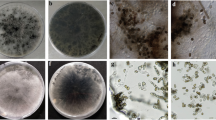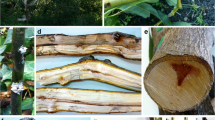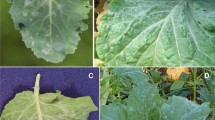Abstract
Browning of the fruit peel around the stem-end region of ripe mangoes, cultivar TomEJC, was observed in a commercial mango plantation in Dambulla, Sri Lanka (Central Province) in 2016. The condition was recognized as a fungal disease, new to mango and named stem-end browning (SEB). The disease commenced as a diffused, yellowish-brown ring around the pedicel and expanded with ripening, covering the upper one-third of ripe fruit. The lenticels within the affected area darkened. A 2–3 cm diameter peel, immediately surrounding the pedicel and the pulp underneath, turned necrotic. The disease did not lead to any softening of the fruit tissues. Ten fungi, isolated from the peel of symptomatic or health fruit, were identified by multi-gene phylogenetic analysis as nine species, Curvularia dactyloctenicola, Diaporthe endophytica, D. eugeniae, D. pseudophoenicicola, Fusarium mangiferae, Neocosmospora sp., Neofusicoccum brasiliense, Neopestalotiopsis rhizophorae and Pestalotiopsis adusta. Most of these fungi could also be isolated from the pedicel or the peel of younger, developing fruits, 2, 4, 6, 8, 10 or 12 weeks after anthesis. Pathogenicity of isolates was tested and confirmed. All nine species produced lesions, slightly variable in size, shape or colour from each other, 8–10 days after inoculation. Different colour forms of the SEB were observed in certain fruit harvesting seasons, probably depending on differences in pathogen combination and dominance. SEB substantially reduced fruit quality, incurring 12–27% postharvest fruit losses. The study describes symptomatology, inoculum source, mode of fruit infection, the identity, phylogeny and pathogenicity of fungi isolated.











Similar content being viewed by others
References
Ajitomi, A., Minoshima, A., Takushi, T., Truong, H. H., Ooshiro, A., Yamashiro, M., Arasaki, C., & Hirooka, Y. (2020). First report of mango (Mangifera indica) stem-end rot caused by two Diaporthe species and their susceptibility to procymidone. Journal of General Plant Pathology, 86, 237–244. https://doi.org/10.1007/s10327-020-00921-7
Botella, L., & Diez, J. J. (2011). Phylogenic diversity of fungal endophytes in Spanish stands of Pinus halepensis. Fungal Diversity, 47, 9–18.
Carbone, I., & Kohn, L. M. (1999). A method for designing primer sets for speciation studies in filamentous Ascomycetes. Mycologia, 91(3), 553–556. https://doi.org/10.2307/3761358
Coutinho, I. B. L., Cardoso, J. E., Cristiano, S., Lima, C. S., Lima, J. S., Gonçalves, F. J. T., Silva, A. M. S., & Freire, F. C. O. (2018). An emended description of Neofusicoccum brasiliense and characterization of Neoscytalidium and Pseudofusicoccum species associated with tropical fruit plants in North-Eastern Brazil. Phytotaxa, 358(3), 251–264. https://doi.org/10.11646/phytotaxa.358.3.3
Diskin, S., Feygenberg, O., Maurer, D., Droby, S., Prusky, D., & Alkan, N. (2017). Microbiome alterations are correlated with occurrence of postharvest stem-end rot in mango fruit. Phytobiomes, 1, 117–127.
Galsurker, O., Diskin, S., Duanis-Assaf, D., Doron-Faigenboim, A., Maurer, D., Feygenberg, O., & Alkan, N. (2020). Harvesting mango fruit with a short stem-end altered endophytic microbiome and reduce stem-end rot. Microorganisms, 8(4), 558. https://doi.org/10.3390/microorganisms8040558
Galsurker, O., Diskin, S., Maurer, D., Feygenberg, O. N., & Alkan, N. (2018). Review: Fruit Stem-End Rot. Horticulturae, 4, 50. https://doi.org/10.3390/horticulturae4040050
Gardes, M., & Bruns, T. D. (1993). Its primers with enhanced specificity for basidioimycetes application to the identification of mycorrhizae and rusts. Molecular Ecology, 2, 113–118.
Glass, N., & Donaldson, G. (1995). Development of primer sets designed for use with PCR to amplify conserved genes from filamentous ascomycetes. Applied and Environmental Microbiology, 61, 1323–1330.
Gomes, R. R., Glienke, C., Videira, S. I. R., Lombard, L., Groenewald, J. Z., & Crous, P. W. (2013). Diaporthe: A genus of endophytic, saprobic and plant pathogenic fungi. Persoonia, 31, 1–41. https://doi.org/10.3767/003158513X666844
Guarnaccia, V., Sandoval-Denis, M., Aiello, D., Polizzi, G., & Crous, P. W. (2018). Neocosmospora perseae sp. nov., causing trunk cankers on avocado in Italy. Fungal Systematics and Evolution, 1, 131–140. https://doi.org/10.3114/fuse.2018.01.06
Johnson, G. I., Mead, A. J., Cooke, A. W., & Dean, J. R. (1991). Mango stem-end rot pathogens - infection levels between flowering and harvest. Annals of Applied Biology, 119(3), 465–473.
Johnson, G. I., Mead, A. J., Cooke, A. W., & Dean, J. R. (1992). Mango stem end rot pathogens - fruit infection by endophytic colonization of the inflorescence and pedicel. Annals of Applied Biology, 120(2), 225–234.
Johnson, G. I., Mead, A. J., Cooke, A. W., & Dean, J. R. (2008). Mango stem-end rot pathogens - fruit infection by endophytic colonization of the inflorescence and pedicel. Annals of Applied Biology, 120(2), 225–234.
Johnson, G. I., Sangchote, S., & Cooke, A. W. (1990). Control of stem-end rot (Dothoirella dominicana) and other postharvest diseases of mangoes (cv. Kensington pride) during short and long-term storage. Tropical Agriculture (Trinidad), 67, 183–187.
Karunanayake, K. O. L. C., & Adikaram, N. K. B. (2020). Stem-end rot in major tropical and sub-tropical fruit species. Ceylon Journal of Science, 49(5), 327–336. https://doi.org/10.4038/cjs.v49i5.7800
Karunanayake, L. C., Sinniah, G. D., Adikaram, N. K. B., & Abayasekara, C. L. (2015). Retention of latex after harvest enhances mango (Mangifera indica L.) fruit resistance and reduces anthracnose and stem-end rot. Australasian Plant Pathology, 44(1), 113–119. https://doi.org/10.1007/s13313-014-0330-7
Kumar, S., Stecher, G., & Tamura, K. (2016). MEGA7: Molecular evolutionary genetics analysis version 7.0 for bigger datasets. Molecular Biology and Evolution, 33(7), 1870–1874. https://doi.org/10.1093/molbev/msw054 Epub 2016 Mar 22.
Li, L., Mohd, M. H., Mohamed Nor, N. M. I., Subramaniam, S., & Latiffah, Z. (2021). Identification of Botryosphaeriaceae associated with stem-end rot of mango (Mangifera indica L.) in Malaysia. Journal of Applied Microbiology, 130(4), 1273–1284. https://doi.org/10.1111/jam.14828 Epub 2020 Sep 28.
Lim, L., Mohd, M. H., & Zakaria, L. (2019). Identification and pathogenicity of Diaporthe species associated with stem-end rot of mango (Mangifera indica L.). European Journal of Plant Pathology, 155, 687–696. https://doi.org/10.1007/s10658-019-01800-4
Marques, M. W., Lima, N. B., de Morais, M. A., Jr., Michereff, S. J., Phillips, A. J. L., & Camara, M. P. S. (2013). Botryosphaeria, Neofusicoccum, Neoscytalidium and Pseudofusicoccum species associated with mango in Brazil. Fungal Diversity, 61, 195–208. https://doi.org/10.1007/s13225-013-0258-1
Meijer, W. (1983). Anacardiaceae. In M. D. Dassanayake & F. R. Fosberg (Eds.), A Revised Handbook to the Flora of Ceylon (Vol. 4, pp. 1–24). Amerind Publishing Co. Pvt. Ltd..
Miller, M. A., Pfeiffer, W., & Schwartz, T. (2012). The CIPRES science gateway: Enabling high-impact science for phylogenetics researchers with limited resources. In: Proceedings of the 1st Conference of the Extreme Science and Engineering Discovery Environment: Bridging from the extreme to the campus and beyond, 1–8 pp.
Murali, T. S., Suryanarayanan, T. S., & Geeta, R. (2006). Endophytic Phomopsis species: Host range and implications for diversity estimates. Canadian Journal of Microbiology, 52(7), 673–680. https://doi.org/10.1139/w06-020
Norphanphoun, C., Jayawardena, R. S., Chen, Y., Wen, T. C., Meepol, & Hyde, K. D. (2020). Neopestalotiopsis rhizophorae Norphanphoun, T.C. Wen & K.D. Hyde. Mycosphere, 10(1), 545.
Prusky, D., Kobiler, I., Miyara, I., & Alkan, N. (2009). Fruit diseases. In R. Litz (Ed.), The mango: Botany, production and uses (2nd ed., pp. 210–231). Wallingford, UK.
Shu, J., Yu, Z., Sun, W., Zhao, J., Li, Q., Tang, L., Guo, T., Huang, S., Mo, J., Hsiang, T., & Luo, S. (2020). Identification and characterization of Pestalotioid fungi causing leaf spots on mango in southern China. Plant Disease, 104(4), 1207–1213. https://doi.org/10.1094/PDIS-03-19-0438-RE Epub 2020 Feb 15.
Singh, Z., & Singh, S. P. (2012). Mango. In D. Rees, G. Farrell, & J. Orchard (Eds.), Crop post-harvest: Science and technology - Perishables (pp. 108–142). Blackwell Publishing Ltd.
Sinniah, G. D., Adikaram, N. K. N., Vithanage, I. S. K., Abayasekara, C. L., Maymon, M., & Freeman, S. (2013). First report of mango malformation disease caused by fusarium mangiferae in Sri Lanka. Plant Disease, 97(2), 427–429. https://doi.org/10.1094/PDIS-09-12-0877-PDN
Slippers, B., & Wingfield, M. J. (2007). Botryosphaeiaceae as endophytes and latent pathogens of woody plants: Diversity, ecology and impact. Fungal Biology Reviews, 21, 90–106.
Stamatakis, A. (2014). RAxML version 8: A tool for phylogenetic analysis and post-analysis of large phylogenies. Bioinformatics, 30(9), 1312–1313. https://doi.org/10.1093/bioinformatics/btu033
Twizeyimana, M., Föster, H., McDonald, V., Wang, D. H., Adaskaveg, J. E., & Eskalen, A. (2013). Identification and pathogenicity of fungal pathogens associated with stem-end rot of avocado in California. Plant Disease, 97, 1580–1584.
White, T. J., Bruns, T., Lee, S., & Taylor, J. (1990). Amplification and direct sequencing of fungal ribosomal RNA genes for phylogenetics. In M. A. Innis, D. H. Gelfand, J. J. Sninsky, & T. J. White (Eds.), PCR protocols - A guide to methods and applications (pp. 315–322). Academic Press.
Acknowledgements
Authors gratefully acknowledge the National Research Council of Sri Lanka (NRC) and the Ellawala Horticulture (PVT.) Ltd. for jointly funding this research through a Public Private Partnership research Grant NRC PPP 17-01. I.G. Weerasuriya Bandara, Chandima Madushani, Viraj Bambarabotuwa and Mayantha Kurera are acknowledged for their contribution in various ways to uphold this research.
Author information
Authors and Affiliations
Contributions
All authors contributed to the conception and design of the study. Material preparation, data collection and analysis were performed by [NKBA], [DMDY], [SSNM], [LM], [DMSD] and [LJ]. The first draft of the manuscript was written by [NKBA, DMDY, SSNM] and all authors commented on subsequent versions of the manuscript. All authors read and approved the final manuscript.
Corresponding author
Ethics declarations
Declarations
The authors declare that this manuscript had not been published elsewhere. All the authors have read the current version of this manuscript and given consent to submit the manuscript.
Ethical approval
No humans or animals were used to conduct the research work presented in this manuscript.
Conflict of interest
Authors have no conflicts of interest relevant to the content of this article to declare.
Rights and permissions
Springer Nature or its licensor (e.g. a society or other partner) holds exclusive rights to this article under a publishing agreement with the author(s) or other rightsholder(s); author self-archiving of the accepted manuscript version of this article is solely governed by the terms of such publishing agreement and applicable law.
About this article
Cite this article
Adikaram, N., Maharachchikumbura, S., Yakandawala, D. et al. Postharvest stem-end browning (SEB) disease in ripe mango (Mangifera indica L.) cultivar TomEJC. Eur J Plant Pathol 165, 447–464 (2023). https://doi.org/10.1007/s10658-022-02616-5
Accepted:
Published:
Issue Date:
DOI: https://doi.org/10.1007/s10658-022-02616-5




